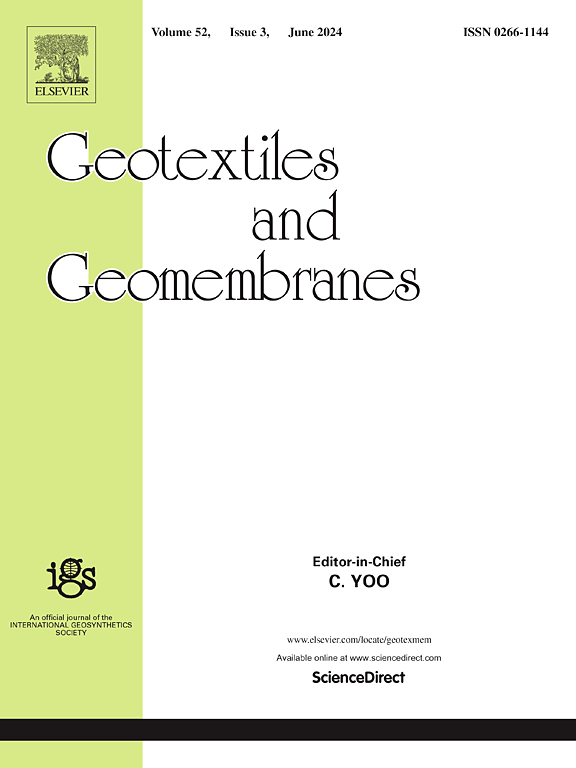土工合成片材在自然污染土壤治理中的吸附和配水性能
IF 6.2
1区 工程技术
Q1 ENGINEERING, GEOLOGICAL
引用次数: 0
摘要
一种新型的水滑石包覆的土工合成吸附片显示了处理开挖土壤和岩石中的地质污染的潜力。在衰减层中使用,它在渗透到周围土壤之前保留渗滤液中的污染物。本研究对该土工合成材料的砷吸附效率和配水性能进行了评价,以评价其现场适用性。批量实验在pH为3-9,温度为5-40°C,并与共存离子(0-500 mg/L的HCO3−,SO42−)进行。结果表明,As(III)和As(V)都能有效去除,其中As(V)的去除效率更高。pH、共存离子和温度对As(V)的去除影响最小,但对As(III)的去除影响显著。特别是,当pH值从9降低到3时,As(III)的吸附效率降低了15%。由于竞争吸附位点,HCO3−和SO42−的存在降低了As(III)的去除。由于吸附过程的吸热性质,在40°C时去除效率略有提高。土壤槽试验表明,土壤粒径是控制土壤保水和排水方式的主要因素。粗砂促进集中流动,细砂增强滞留和分散。在测试条件下,土工合成吸附片仅显示有限的水力影响。本文章由计算机程序翻译,如有差异,请以英文原文为准。
Sorption and water distribution performances of a geosynthetic sheet used in naturally contaminated soils management
A novel hydrotalcite-coated geosynthetic sorption sheet shows potential for managing geogenic contamination in excavated soils and rocks. Employed in an attenuation layer, it retains contaminants in leachate before infiltration into surrounding soil. This study evaluates the arsenic (As) sorption efficiency and water distribution performance of this geosynthetic material to assess its field applicability. Batch experiments were conducted across a pH range of 3–9, temperatures of 5–40 °C, and with co-existing ions (HCO3−, SO42− at 0–500 mg/L). Results demonstrated effective removal of both As(III) and As(V), with higher efficiency for As(V). While pH, co-existing ions, and temperature had minimal effect on As(V) removal, they significantly influenced As(III) removal. Specifically, As(III) sorption efficiency decreased by 15 % as pH decreased from 9 to 3. The presence of HCO3− and SO42− reduced As(III) removal due to competition for sorption sites. Removal efficiency slightly improved at 40 °C due to the endothermic nature of the sorption process. Soil tank experiments indicated that soil particle size was the dominant factor controlling water retention and drainage patterns. Coarse sand promoted concentrated flow, while finer sands enhanced retention and dispersion. The geosynthetic sorption sheet showed only a limited hydraulic influence under the tested conditions.
求助全文
通过发布文献求助,成功后即可免费获取论文全文。
去求助
来源期刊

Geotextiles and Geomembranes
地学-地球科学综合
CiteScore
9.50
自引率
21.20%
发文量
111
审稿时长
59 days
期刊介绍:
The range of products and their applications has expanded rapidly over the last decade with geotextiles and geomembranes being specified world wide. This rapid growth is paralleled by a virtual explosion of technology. Current reference books and even manufacturers' sponsored publications tend to date very quickly and the need for a vehicle to bring together and discuss the growing body of technology now available has become evident.
Geotextiles and Geomembranes fills this need and provides a forum for the dissemination of information amongst research workers, designers, users and manufacturers. By providing a growing fund of information the journal increases general awareness, prompts further research and assists in the establishment of international codes and regulations.
 求助内容:
求助内容: 应助结果提醒方式:
应助结果提醒方式:


